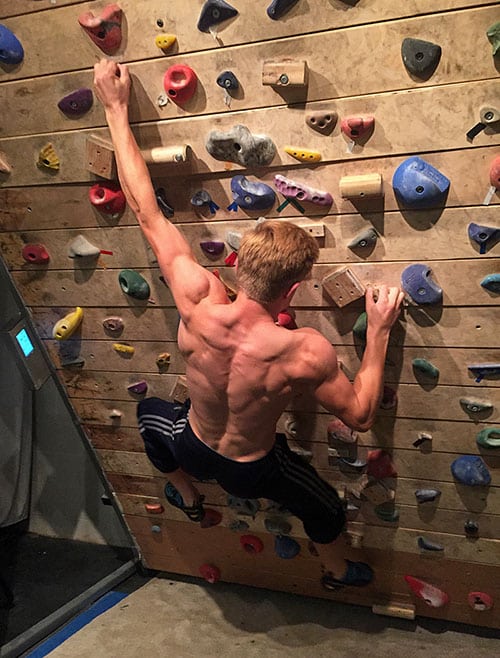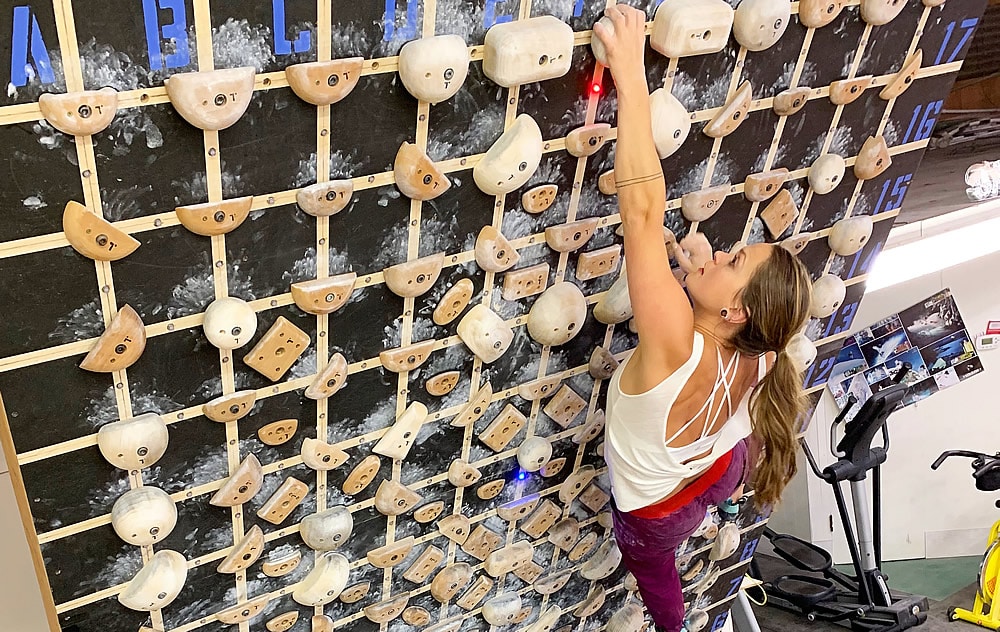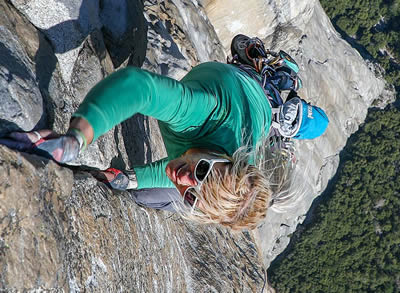Learn how to increase your power-endurance with five proven training protocols for powering-up and beating the burn to the boulder top or chains!
Power-endurance is at the heart of many climbing objectives. While power training targets peak anaerobic output and endurance training targets sustained aerobic capacity, power-endurance training combines the two. Think of it as the ability to prevail through multiple intermittent bursts of high power output. That’s exactly the kind of fitness climbers need to tackle hard sport routes dotted with crux zones or put in repeated maximum efforts on a limit boulder problem.
Towards this end, interval training is the proven training modality—but the training must be sport-specific. Just as runners, cyclists, and swimmers hit the track, road, and pool for their interval training, climbers need to execute interval training on the wall. No matter the sport, effective interval training must be properly structured, appropriately dosed, and executed with discipline to get the optimal training stimulus.
Done right, the body will adapt in ways that accelerate recovery between efforts and increase your capacity to summon repeated bursts of high power output when pushing your limits on boulders or routes. The primary training adaptations to credit for these vital gains are improved intra- and extracellular buffering of H+ ions (acidosis), improved lactate shuttling, increased mitochondria efficiency, as well as numerous enzymatic changes.
Detailed below are five interval-training protocols for boosting your power-endurance on the rock. Engaging in one or two of these routines just a couple of times per week will increase your capacity to do consecutive hard moves, resist fatigue, and endure the pump all the way to the boulder top or the chains!
Bouldering 4x4s
This is the tried and true classic method of training power-endurance. Begin by picking out four different boulder problems two to three grades below your max. For example, a V8 boulderer would likely feel best on V5 or V6 boulders for this exercise. Make sure that these boulder problems are consistently doable for you, the key word here being consistently. The goal will be to complete these problems four times in a row each without reaching the point of failure, but brushing right up against it. These problems should also be fairly straightforward and short so that no one climb takes more than 30 seconds or requires too much intricacy.
If you have access to interactive climbing boards like the Kilter, Moon, or Tension, these make perfect platforms for 4×4’s because of their size and the ease of switching between problems with the simple swipe of a finger. Also, think about selecting problems that favor big moves on big holds as opposed to more technical climbs on primarily small holds. You want to target full-body pulling power more than technique or finger flexor strength.
Lap the first boulder four times in a row with just a brief shake out and rechalk between goes—at the most, rest equal to the amount of time you spent climbing on the preceding lap, then hop right back on the wall for the next go. After you’ve sent the boulder four times, rest for about five minutes. Trading off with a partner works well here in terms of timing since your partner can do her four ascents while you’re taking the five-minute rest.
Repeat the same process on the other three boulder problems. If you’ve targeted the right level of challenge for each set, you should be able to just barely complete the final round of four. Should you find yourself failing before the end or finishing with plenty of gas left in the tank, tweak your climb choices accordingly the next time you perform this exercise.
Square Dance
Hop on an interactive climbing board, systems wall, or campus board for this exercise. Start with your hands matched on a low hold and your feet centered beneath your body. Reach up as high as you can to latch a hold or rung directly above your shoulders. Match that same hold or rung with your other hand, keeping your feet in their original position. Hang in this extended position for just a couple of seconds, then drop the first hand back to the original starting hold and match this with the second hand. Hang here briefly before repeating the process starting with the second hand this time.
Keep repeating the “square dance” for about two minutes straight. Then, rest for two minutes before starting the next set. Don’t expect to feel fully recovered by the time your rest period ends, but enough to get back on for a total of two to four rounds. If the dance begins to feel too intense to maintain, decrease the distance between holds.
EMOM
EMOM stands for “Every Minute, On the Minute”. Set a timer for eight to ten minutes and set out to climb the same number of boulders as minutes on the clock. Each of these boulders should be two to four grades below your maximum. As soon as the timer starts counting down, climb the first problem with efficiency and fluidity in mind. Then, rest until the timer reaches the top of the next full minute. Repeat by starting a new climb every minute, only resting in the time between completing one climb and the start of the next full minute.
Though it might be tempting to rush your climbs so you get more rest in between goes, remember to stay smooth as you move. Climbing too hurriedly will only foster poor technique. Aim for efficiency over urgency. Move onto easier boulders as needed to complete the eight or ten sets. Get ready for some heavy breathing!

30-30 “sprint” intervals on a Treamwall!
30”/30” Intervals (aka. “Hörst Interval Protocol”)
This is coach Hörst’s patented interval scheme for elite-level climbers wanting to power up for cutting-edge ascents. If you stick to the protocol exactly it will exhaust alactic power and build aerobic power (to drive alactic recovery ability) without getting too lactic and acidy (thus, lowering the risk of overtraining syndrome over a few weeks of P-E training).
Do your 30/30s on a spray wall, home woodie, system board, or Treadwall with a wide variety of holds. You will not be climbing specific problems, so there’s no focus on actual sending—the goal is to just climb intuitively at all-out intensity for exactly 30 seconds. Use the smallest holds and make the biggest moves possible without falling off the wall. Therefore, as you fatigue you’ll need to use somewhat bigger holds and make smaller, less-powerful movements.
Continue 30 seconds on the wall (all-out max-intensity climbing) and 30 seconds off (shaking out, chalking up, and breathing deeply) for a total of 6 intervals. Now, take 5 to 10 minutes of complete rest, before doing another set of six 30/30 intervals.
Well-conditioned climbers can continue in this fashion for up to four sets of six 30/30 intervals. Elite climbers may even consider wearing a five- or ten-pound weight belt or vest to raise the intensity of the training even higher!
Campus Rung Sprints
This exercise is the closest you can get to traditional sprint intervals applied to climbing. Rather than running 40-yard gasers like a football or hockey player would do, you will “arm sprint” up the larger rungs on a campus board. If you’re a strong board climber, ladder up by skipping rungs. For example, 1-3-5-7-9 with a hand-match on rung 10, then carefully jump down. Otherwise, hand-over-hand up the board using every rung. Either way, go as fast as possible—for most folks, the sprint to the top will take between 3 and 8 seconds.
Now, rest for 30 seconds, before launching into your next arm sprint up the campus board. Continue in this fashion for a total of five to ten sprints. End your campus rung sprint session if you fail to reach the top with any set…or if you sense that shoulder and scapular fatigue is compromising your technique (i.e shrugged, disengaged shoulders).
Programming Tips
Power-endurance training is hard on the body, so limit yourself to just two or three sessions per week. From an energy system training perspective, it’s vital to understand that the anaerobic lactic system is the least trainable of the three energy systems. Two to four weeks of power-endurance training will top off your tank ahead of a period of performance climbing (taper appropriately). Training with power-endurance protocols for any longer commonly leads to overtraining syndrome with reduced high-end performance and heightened risk of injury or illness.
While it’s beyond the scope of this article, I’ll tease you with the concept that long-term gains in power-endurance actually come by way of leveling up alactic (maximum strength) and aerobic (critical) power. Therefore, committing to frequent periods of polarized maximum strength and aerobic capacity training is the secret to developing elite-level power-endurance in successive climbing seasons. I invite you to explore the five Training For Climbing podcast episodes that provide rich detail on the science and protocols central to effective energy system training.
- Energy System Podcast – Alactic Training
- Energy System Podcast – Power-Endurance Training – Part 1 (Lactic System)
- Energy System Podcast – Power-Endurance – Part 2 (Lactic System)
- Energy System Podcast – Climbing-Specific Aerobic Training
- Energy System Podcast – The Art of the Science (Programming and FAQ)
Copyright © 2000–2024 Lucie Hanes & Eric J. Hörst | All Rights Reserved.











